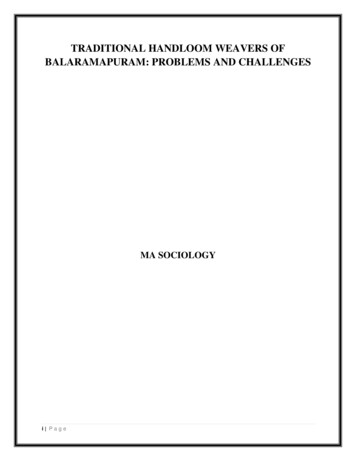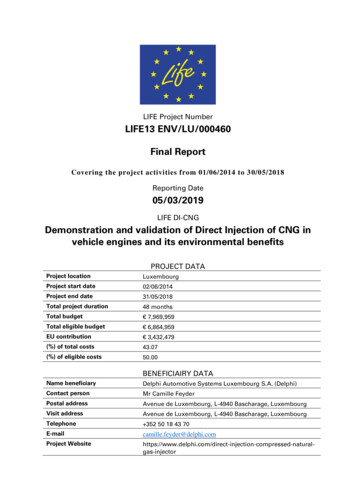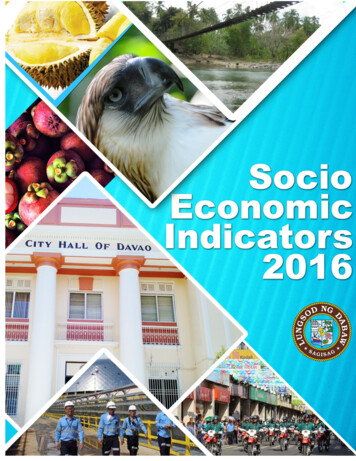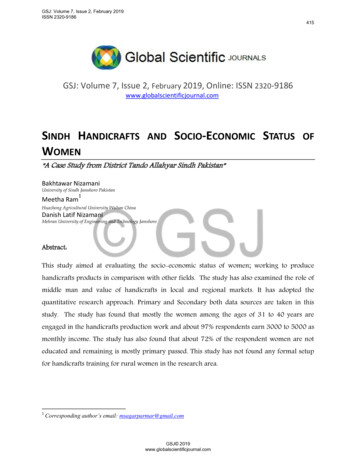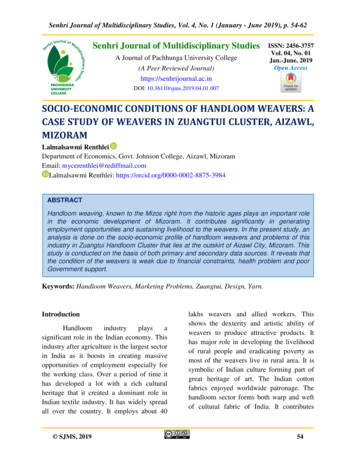
Transcription
Senhri Journal of Multidisciplinary Studies, Vol. 4, No. 1 (January - June 2019), p. 54-62Senhri Journal of Multidisciplinary StudiesA Journal of Pachhunga University College(A Peer Reviewed Journal)https://senhrijournal.ac.inISSN: 2456-3757Vol. 04, No. 01Jan.-June, 2019Open AccessDOI: 10.36110/sjms.2019.04.01.007SOCIO-ECONOMIC CONDITIONS OF HANDLOOM WEAVERS: ACASE STUDY OF WEAVERS IN ZUANGTUI CLUSTER, AIZAWL,MIZORAMLalmalsawmi RenthleiDepartment of Economics, Govt. Johnson College, Aizawl, MizoramEmail: mycerenthlei@rediffmail.comLalmalsawmi Renthlei: oom weaving, known to the Mizos right from the historic ages plays an important rolein the economic development of Mizoram. It contributes significantly in generatingemployment opportunities and sustaining livelihood to the weavers. In the present study, ananalysis is done on the socio-economic profile of handloom weavers and problems of thisindustry in Zuangtui Handloom Cluster that lies at the outskirt of Aizawl City, Mizoram. Thisstudy is conducted on the basis of both primary and secondary data sources. It reveals thatthe condition of the weavers is weak due to financial constraints, health problem and poorGovernment support.Keywords: Handloom Weavers, Marketing Problems, Zuangtui, Design, Yarn.IntroductionHandloomindustryplaysasignificant role in the Indian economy. Thisindustry after agriculture is the largest sectorin India as it boosts in creating massiveopportunities of employment especially forthe working class. Over a period of time ithas developed a lot with a rich culturalheritage that it created a dominant role inIndian textile industry. It has widely spreadall over the country. It employs about 40 SJMS, 2019lakhs weavers and allied workers. Thisshows the dexterity and artistic ability ofweavers to produce attractive products. Ithas major role in developing the livelihoodof rural people and eradicating poverty asmost of the weavers live in rural area. It issymbolic of Indian culture forming part ofgreat heritage of art. The Indian cottonfabrics enjoyed worldwide patronage. Thehandloom sector forms both warp and weftof cultural fabric of India. It contributes54
Senhri Journal of Multidisciplinary Studies, Vol. 4, No. 1 (January - June 2019), p. 54-62nearly 15% of the cloth production in thecountry and also contributes to the exportearnings of the country. 95% of the world‟shand-woven fabric comes from India.In respect of Mizoram in particular,handloom industry occupies a distinctiveand important place in the indigenousculture2 of Mizoram. After agriculture,handloom industry is one emerging sectorthat has generated huge employment for theskilled and unskilled labour. Mizoram hashuge potential for investment particularly inthe field of handloom and handicrafts. Inearlier times, Mizo women expressed theircraftsmanship through the decorativeweaving with the use of a loin loom or backstrap loom, creating designs, patterns andmotifs woven. Puan is the cloth, which iswoven. „Puan‟ in Mizo language can meanany piece of cloth, and even when it is tiedon the waist and worn as a lower garment, itis still called „puan‟. A puan is normallyabout a yard in length and from 44 inches to54inches in breadth. The decorative weavingdone on the surface of the cloth is known asZeh. Puan were the only garments duringthe earlier periods, worn by both Mizo menand women.Weaving still holds an integral partin the Mizo life. The handloom products arefamous for the use of vibrant tribal colorcombinations which are very distinct fromother traditional attires of the country.Intricate designs are made on the traditionaltextiles and the demands for these textilesare ever increasing. They are designed bycopying motifs and patterns from othertraditional textiles. Puan are also takenoutside the state for exhibition cum sale. SJMS, 2019Significance of the StudyHandloom industry plays a crucialrole in the socio-economic development ofthe rural masses in the north eastern region.Despite the largest concentration ofhandlooms in the country (more than 65% ofthe total looms) a majority (62%) of thelooms in NE states are engaged in domesticproduction only. Majority of the weavers arewomen and through this, they have found aniche in the international markets ofhandloom. This has made them self-reliantfinancially and help them lead life withdignity and respect. There has been a lot ofstudy on Thenzawl Cluster while there is alack of it in the case of Zuangtui Cluster,Aizawl. This study is important in findingout the socio-economic conditions ofweavers in Zuangtui Cluster who have beencontributing a lot in handloom productionin Mizoram especially Aizawl City.Study AreaZuangtui Industrial Estate is locatedat the outskirt of eastern part of Aizawl City,Mizoram. The area comprises of varioussmall-scale industries like Cotton Mills,Bakery, Flour mills and handloomindustries. Zuangtui Handloom Cluster wasdeveloped by the Government of Mizoramin December, 2015. At present there arearound 400 weavers.Objectives of the StudyThe objectives of the study are:1) Tostudythesocio-economicconditions of the handloom weavers ofZuangtui Handloom Cluster.55
Senhri Journal of Multidisciplinary Studies, Vol. 4, No. 1 (January - June 2019), p. 54-622) To examine the problems andprospects of the handloom industry inthis cluster.Table 1: Age of WeaverSl. No.Age Group% ofRespondentsMethodologyBased on primary data that wascollected from 120 respondents by using astructured questionnaire and through aninformal personal interview method andsecondary data that was collected frombooks, periodic journals, articles related tothe present research, this study wasconducted.Primary Data: Primary data arecollected from 120 weavers working undersocieties or independent weavers. For datasurvey a structured questionnaire is usedwhich contain simple, multiple choicequestions. Observation method and personalinterview method are also used forcollection of primary data.Secondary Data: Sources ofsecondary data like published andunpublished reports by the government,departments and societies of the handloomsector, books and periodic journals are usedfor collection of secondary data for thisstudy.Data Analysis and InterpretationThe data is collected from 120sample respondents by using a . The data is analyzed by usingpercentage method on the basis of age, sex,marital status, educational level, income permonth, type of product, various problems ofhandloom weavers, weaver‟s health etc. SJMS, 2019123456Below 201020 - 305031 - 403541 - 502.551 above2.5Total100Source: Field SurveyAccording to the above table, amajority of the respondents are in betweenthe age of 20-30 years i.e. 50% of the totalrespondents, 35% of the respondents are inbetween the age of 31-40 years. It isobserved that only 2.5% of the respondentsare above the age of 41 yearsTable 2: Gender of WeaverSl. No.123Gender% of workerMale30Female70Total100Source: Field SurveyOf the sample 120 weavers, 70%consists of female weavers whereas 30%belongs to male weavers. As weaving ismainly considered to be the work of womenfrom historic period (Sangkima 2004), thecomposition of weavers shows the majorityof female weavers in the study area as well.Most of the male weavers are fromMyanmar.56
Senhri Journal of Multidisciplinary Studies, Vol. 4, No. 1 (January - June 2019), p. 54-62Table 3: Marital Status of WeaverSl. No.12345Marital% of cee3.5Total100Source: Field SurveyAccording to the above data, 49% ofthe total weavers are single and 45% aremarried, 2.5 % are widow or widower and3.3% are divorcee.Table 4: Educational Level ofRespondentsSl. No.12345Educational% of weaverLevel1 to 545.86 to 1036.611 to 1214.3Graduates3.3Total100Source: Field SurveyRegarding the educational level ofthe weavers, all the respondents are literates.Among these respondents 45.8% are below5th class and 36.6% are in between class 6 to10 while 14.1 % belongs to highersecondary and very few 3.3% are graduates.Table 5: Category of WeaverSl. No.1234Categoryof %ofweaverweaverIndependent15.8weaverUnder middlemen70.8Co-operative13.4weaverTotal100Source: Field Survey SJMS, 2019According to the above data, 15.8%of the respondents are independent weaverswho have their own looms and do theweaving in their own house whereas 70.8%are weavers under middlemen and only13.3% are co-operative weavers.Table 6: Working Hours Per DaySl. No.12345Working% of weavershoursUpto 6 hours0.836 to 8 hours2.58 to 10 hours30.810 hours above65.8Total100Source: Field SurveyIn terms of hours spent per day inweaving, 65.8% of the respondents workmore than 10 hours a day; 30.8% work for 8to 10 hours per day and 2.5% work for 6 to8 hours a day and hardly 1% work upto 6hours a day.Table 7: Monthly Income of theRespondentsSl.No.12345Monthly income% of weaversUpto 1500015001 - 2000020001- 25000Above 25000TotalSource: Field Survey58.35.823.312.5100According to the above data, about58.3% earn a monthly income of upto Rs15000/- and 5.8% earn between Rs 15001 to20000; 23.3% earn a monthly incomebetween Rs 20001 and 25000/- and 12.5%earn monthly income above Rs 25000/-.57
Senhri Journal of Multidisciplinary Studies, Vol. 4, No. 1 (January - June 2019), p. 54-62Table 8: Experience in handloom weavingSl. No.12345Years of% of weaversexperience0 -5706 - 1020.811 - 154.1615 above5Total100Source: Field SurveyRegarding the years spent onweaving, 70% of the weavers have anexperience of weaving upto 5 years; 20.8%have an experience of 6 to 10 years and14.16% of them have an experience of 11 to15 years and 5% have an experience ofweaving for more than 15 years.Table 9: Health ProblemsSl. No.1234567Sickness% of weaversEye sight9.16Back pain24.1Knee pain6.6Joint pain3.5Others33.3NIL23Total100Source: Field SurveyAccording to the above data, themost common health problem is back painwhich 24.1% of the weavers have; 9.16%have an eye sight problem, 6.6% havingknee pain; 3.3% with joint pain; 33.3%complain about other illness like stomachproblem, headache, nerve problem etc. andinterestingly about 28% have no complaintabout their health. SJMS, 2019Table 10: Product Type TableSl. No.1234Product type % of 6.6Total100Source: Field SurveyIn the case of product type, 80.9% ofthe weavers produce „thilchhah‟3 plain and„thilchhah‟ designed; 16.6% of themproduce „puanzeh’ and only 2.5% areproducingtraditionalPuancheiorNgotekherh.Table 11: Marketing problemsSl. No.123Marketing% ofproblemsweaversYes8.3No91.6Total100Source: Field SurveyAccording to the above data, 91.6%of the weavers have no problems regardingmarketing of their produce whereas 8.3% ofthem have marketing problems.Table 12: Financial problemsSl. No.123Financial% of weaversproblemsYes21.6No78.3Total100Source: Field SurveyAccording to the above data, 78.3%of the weavers have no problems regardingfinance and 21.6% of the weavers havefinancial problems.58
Senhri Journal of Multidisciplinary Studies, Vol. 4, No. 1 (January - June 2019), p. 54-62Table 13: LandholdingsSl. No.1234Land% of weaversholdingsAgricultural4.16landLand for9.16householdNo land86.6Total100Source: Field SurveyAccording to the above data, 86.6%of the weavers have no landholdingswhereas 9.16% have landholdings forhousehold and 4.16% have landholdings foragriculture.Table 14: Possession of assetsSl. No.1234Assets% ofpossessedweaversTelevision set2.5Mobile79.16handsetNone of the18.3aboveTotal100Source: Field SurveyIn terms of asset possession, 79.16%have mobile handset and 2.5% haveTelevision set and 18.3% have none of theabove assets at all.Table 15: Bank account holderSl. No.123Account% ofholderweaversYes34.16No65.83Total100Source: Field Survey SJMS, 2019According to the above data, 65.83%do not have bank account and 34.16 havethe same. The figure is less for accountholder mainly because Burmese weavers /foreigners fall into this category.Table 16: Assistance from GovernmentSl. No.123Assistance from% ofGovernmentweaversYes13.3No86.6Total100Source: Field SurveyAccording to the above data, only13.3% of the weavers have got assistancefrom Government and it was found out thatthey are the co-operative weavers only andthe rest, 86.6% working as independentweavers, have not availed any assistancefrom the government.Table 17: DesigningSl. No.1234Designing% of weaverOwn design8.3Design ordered12.5by buyersMarket79.16demandTotal100Source: Field SurveyAccording to the above data, only8.3% of the weavers produce their owndesign. This shows that only few weaverspossess skills in designing new motif thathas not been available in the market toattract buyers and 12.5% produce designordered by the buyers of that particularproduct. 79.16% of the weavers produce59
Senhri Journal of Multidisciplinary Studies, Vol. 4, No. 1 (January - June 2019), p. 54-62design according to the demand prevailingin the market.FindingsZuangtui Handloom Cluster has twotypes of problems - Input related problemsand Weavers related problemInput related problems may include: Delay in supply of yarn: Sometimesthe supply of yarn may be delayed forthe recognised authority. Then thesociety cannot produce the product atthe right time. Automatically they areforced to go to purchase the yarn fromlocal source that tends to reduce thequality of product. High cost of production: Co-operativesocieties are facing the problem oflimited finance for their operation justas in the case of “A report of surveyon handloom sector in ticsofGovernment of Kerala (2009). In thecase of Zuangtui Cluster, financialsupport received by the co-operativeweavers is so meager to have hugeimpact on the socio-economicconditions of the weavers. Cost ofproductionsometimesincreasescompared to previous year. This maylead to shortage of finance. In order tosolve these problems, the apexauthority should take remedial action. Inadequacy of supply of yarn:Sometimes there is inadequacy ofsupply of yarn in terms of colours ofdifferent variety that affects the entireproduction of the cluster. Due to the SJMS, 2019unavailability of good quality cottonyarn, they have to use only the yarnsavailable i.e., acrylic and rayon. Theseyarns are not suitable for hot regions;thus, the products are not saleable inmany parts of the country. This similarproblem was found in the case of astudy done by Venkateswar, A (2014)when he studied the socio-economicconditions of the handloom weaversand the problems faced by thehandloom weavers.Weaver‟s related problems include: Lack of skilled weavers: Skilled andefficient labours are centralized figureof every organisation. In the case ofweavers, there is no need to achievehigh qualification and high skill.Naturally, that will lead to a headacheto cooperative society. Lack of training: It is the duty of thegovernment to arrange advancetraining to co-operative weavers‟societies. The state government hardlyconduct training for the weavers. Poor knowledge about modernisedtechnique and low performance of cooperative sector: Due to lack oftraining and updating, the knowledgeof weavers is very limited and theyhave no idea about modernizedtechnique and design. This is majorhindrance of development in this field.The same case was found in the studyof D. Srinivasa Rao and Dr. N.Sreedhar(2017)about“socioeconomic condition of handloomweavers in Gannavaram Mandal ofKrishna district in Andra Pradesh.60
Senhri Journal of Multidisciplinary Studies, Vol. 4, No. 1 (January - June 2019), p. 54-62This study is based on extensive fieldwork that indicates that thoughhandloom weaving has many strengthsand can be competitive under specificcondition, the seeds of the crisis areinherent in the sector. These can betraced to two major factors - the lowperformance of the co-operative sectorand the very low economic conditionof the weavers. Even in the case ofZuangtui, there has been lowperformance of co-operative sectorthat aggravates the poor economiccondition of the weavers.SuggestionsRegarding the above problems, thestate government should pay more heed tothe development of handloom industry in theregion. Due to the small size of the houses,condition of weavers‟ work place is patheticand problem of congestion in the work placeis serious. Government should provide betterinfrastructure for the weavers.Most of the weavers are Burmesethat says a lot about the work culture of thelocal people. They lack hard work andperseverance that the Burmese have intaking up weaving activity. Governmentshould organize awareness campaign aboutthe feasibility of handloom weaving inMizoram as a whole.weavers so that their products become moremarketable in national as well asinternational market.ConclusionHandloom occupies a vital place inMizoram economy in shaping the socioeconomic fabric of society. This studyindicates that though the Handloom industryoffers a massive amount of employmentopportunities, it is facing a lot of problemsespecially socio-economic problems likepoor economic condition of the weavers,input related problems and the poorperformance of the cooperative sector.Eventhough it plays vital role in reducingpoverty, increasing employment, andenhancinghouseholdincomeandconsumption in the state, this sector facesvarious challenges in the field of creativeand innovative design that would increasethe market value of the product both inlocal and national market. Therefore,financial, technical and policy supports ofthe Government for development ofhandloom industry in Mizoram is the needof an hour.Endnotes1Annual Report 2017-18, MinistryTextiles, Government of India.of2The youths of the state should beencouragedandinspiredthroughsensitization programmes to take up selfemployment opportunity in the field ofhandloom weaving.It is a distinctive culture that the indigenouspeople practice from time immemorial.3Double-woven cloth.4India.gov.in national portal of India 2009.Regular training programme indesigning should be conducted for the SJMS, 201961
Senhri Journal of Multidisciplinary Studies, Vol. 4, No. 1 (January - June 2019), p. 54-62ReferencesNarasaiah, M. L. 2001. Economics ofHandloomIndustry,SonaliPublication.Sangkima, 2004. A Modern History ofMizoram, Spectrum Publications,Guwahati.Satyajit Das, „Present Scenario and SomeProblems of Handloom Industry: AStudy with Handloom Weavers inTuganganj Block–I of Cooch BiharDistrict West Bengal‟ in InternationalJournal of Research in Humanities,Arts and Literature, 2018; 6(9) pp153-170.Shamitha, K. V, & Balasubramanian, P.,„Socio-EconomicConditionofHandloom Weavers: A Study withSpecial Reference to HandloomWeavers Co-operative Society in SJMS, 2019KannurDistrict‟InternationalJournal of Pure and AppliedMathematics, 2018 :119 (16) pp:1411-1423.Srinivasa Rao, D., & Dr. Sreedhar, N.„Problems of handloom weavers inAndhra Pradesh: A study of KrishnaDistrict‟ in International Journal ofHumanities and Social ScienceInvention, 2017; 6 (11) pp: 42-49.Varghese Anu & Dr. Salim M. H.„Handloom Industry in Kerela: Astudy of the problems and challenge‟inInternationalJournalofManagement and Social ScienceResearch Review, 2015; 1(14) p: 347.Venkateswar, A. 2014. „A Socio-EconomicConditions of Handloom Weaving: AField Study in Kallidaikurichi ofTirunelveli District‟ in InternationalJournal of Social Science &Humanities Research, 2(2), pp 38-49.62
of the respondents are independent weavers who have their own looms and do the weaving in their own house whereas 70.8% are weavers under middlemen and only 13.3% are co-operative weavers. Table 6: Working Hours Per Day Sl. No. Working hours % of weavers 1 Upto 6 hours 0.83 2 6 to 8 hours 2.5 3 8 to 10 hours 30.8 10 hours above 65.8

